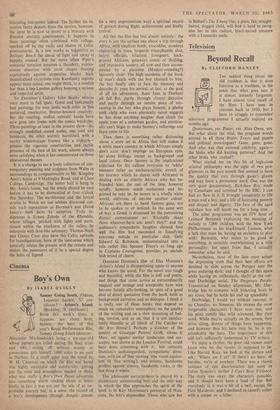Art
Recognition
By NEVILE WALLIS
WHEN Kurt Schwitters was in- terned in a Scottish camp during the last war, I was told a story not related by his son in his moving appreciation of the German innovator whose retrospective exhibition now fills the Marlborough Gallery. Required at some continental barrier to open his dilapidated little suitcase, Schwitters disclosed one celluloid collar and a bundle of his MERZ literature—'both,' as he buoyantly admitted, 'highly inflammable.' The philosophic refugee was waved aside as a crank; and indeed was so regarded here until slowly, after his death in 1948, his achievement came to be recognised and his purposeful fabrications of discarded odds and ends seen to foreshadow styles today in general currency.
Schwitters was an abstract artist as intuitively certain of his movements as a duck in water. After practising academic painting and an ex- pressionist variant of cubism, he came to abstraction around 1918 and his MERZ assem- blages seemed to follow naturally. The torn fragment of a poster, `CommEnz and Privatbank,' revealing just those four letters in his glued composition, gave Schwitters the title he assigned to all his fertile activity in collage and relief assemblages, writing and experimental poetry. His pictorial use of tickets, banknotes, scraps of machinery, and so forth, associated him for a while with the anti-art of ,the Dadaists, whom he offended just because of the conscious beauty and rightness with which these elements are held in tension, given their thrusts and counter- thrusts, and harmonised often with mauve, green and yellow.
Schwitters's desire to construct something durable out of the litter of a civilisation destroyed by the First German War gives these works their sanction, as time has conferred on the grandest a peculiar aura and dignity. Quickening it all is the missionary zeal common to those pioneers associated with movements like De Still; an in- tegrity the fiercer for the hostility and often persecution which oppressed them, such as can never be experienced by their adventurous suc- cessors, supported by commercial interests and benefiting from the lessons of hindsight. More copiously than the earlier Lord's Gallery ex- hibition, the Marlborough's brings out the extraordinary range of ideas and moods ex- pressed in these assemblages, taking their com- plexions as much from the artist's frequent changes of scene as from his volatile nature.
The recent work of John Piper at the New London Gallery, by contrast, exacts little more than his displays of technical virtuosity with effects which flash on the consciousness and fade as swiftly as firework tableaux. Architec- tural subjects have, in the past, best suited his easel painting. When his sportive fancy is in tune with exuberant baroque statuary or the shimmer on Venetian palaces he may be an ex- hilarating interpreter indeed. The farther his in- ventive fancy departs from the motive, however, the apter he is now to resort to a bravura with flimsiest abstract contrivances. It happens in these paintings often combined with collage, sparked off by the rocks and shores of Celtic promontories. In a few works as suggestive as Brittany Beach the dance of light and spray is happily evoked. But far more often Piper's romantic notation assumes a thundery, expres- sionist direction with vivid shapes floating capriciously against serpentine blacks. Such theatricalised excursions into Kandinsky regions appear more suited, one might think, to a modish bar than a top London gallery housing a serious and respected artist.
To Zwemmer's Gallery John Bratby returns once more in full spate. Good and ludicrously bad paintings for ever jostle each other in this perfervid, unselective, Bratter-brained creativity. But the snarling, stuffed animals' heads have now gone into limbo with the comic wardrobe. Three paintings at least in the present show—his strongly modelled seated nudes, one cool and luminous, the other warmly burnished, with a snowy windowscape framed like a triptych— possess the vigorous construction and tactile presence of the best of his work, almost always most satisfying when it has concentrated on those obsessional themes.
It is a change to see a lively collection of con- temporary painting and sculpture from Wales in surroundings as companionable as Mr. Kingsley Amis's house at 9 Madingley Road, and at Clare College, Cambridge. The better half is hung in Mr. Amis's house, but the whole should be seen before it has to be dismantled at four o'clock this Saturday. The earthbound and the lyrical strains in Welsh art too seldom discussed out- side such reputations as Herman's and David Jones's—both heirs by adoption. Truly in- digenous is Ernest Zobole of the Rhondda, whose villages, pricked with lights and parti- tioned within the blackness of the valley, he interprets with ikon-like solemnity. Thomas Nash and Glenys Cour also have this Celtic aptitude for transfiguration, born of the time-sense which naturally relates the present with the remote and makes the possessors of it in a special degree the heirs of legend.



































 Previous page
Previous page